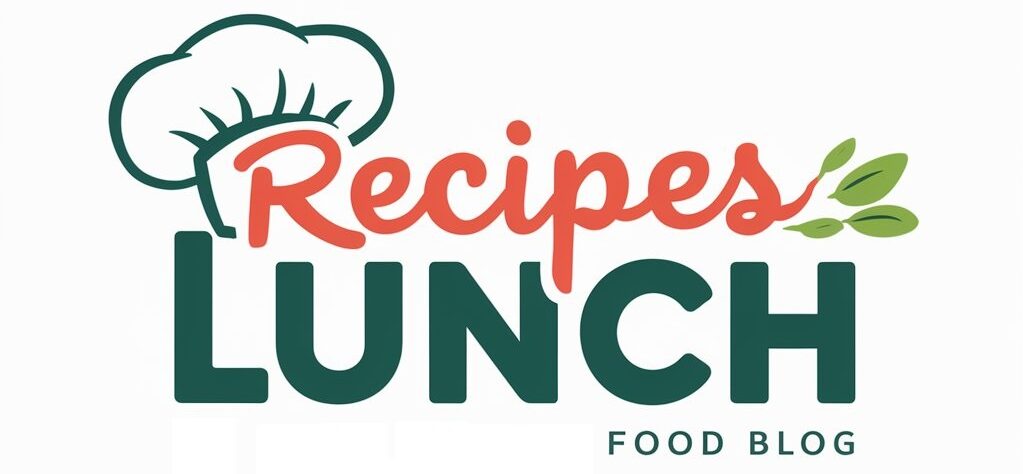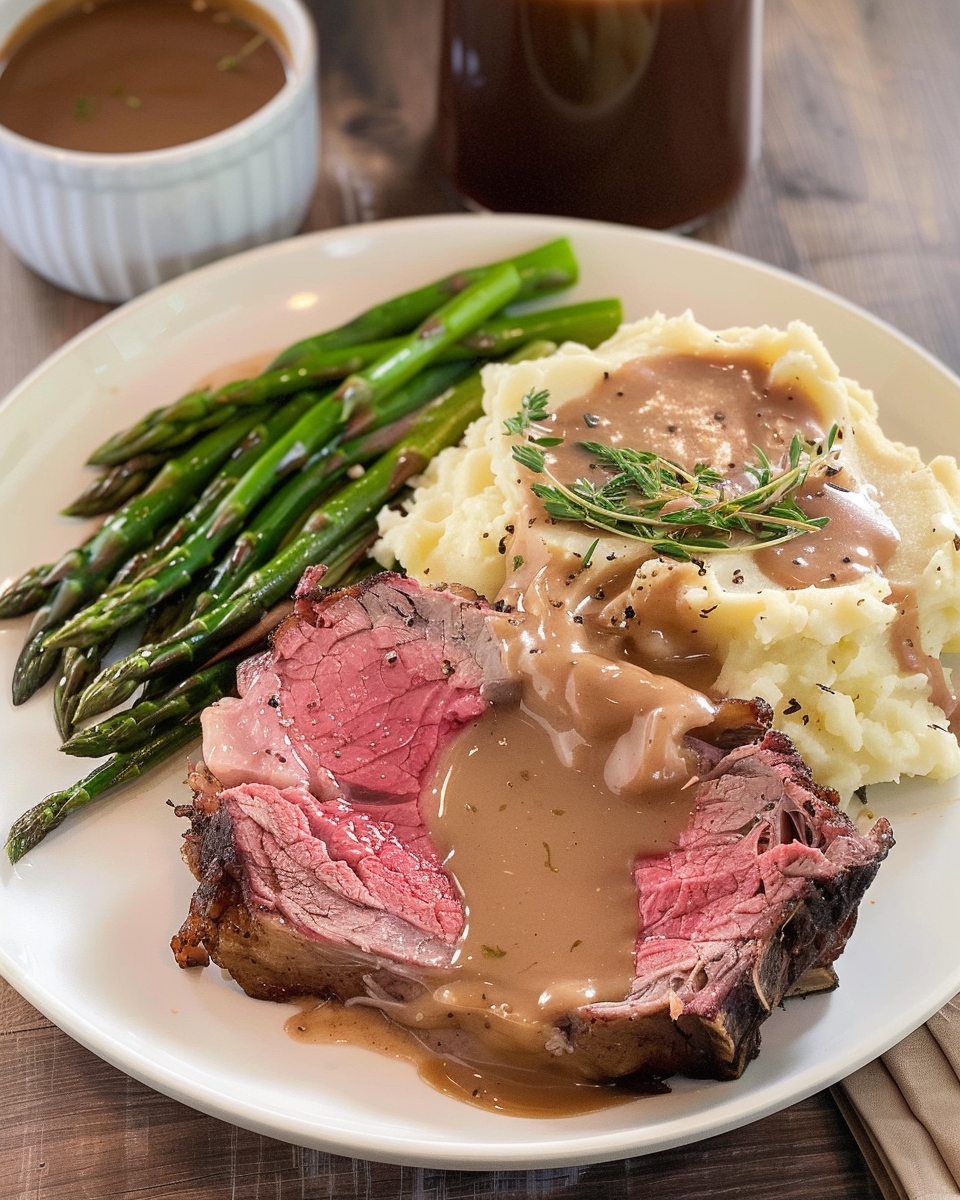Introduction
There’s nothing quite like the luxurious experience of enjoying a perfectly cooked Reserve Prime Rib. When paired with creamy mashed potatoes, crisp roasted asparagus, and finished off with a rich, savory gravy, it creates an unforgettable meal that’s ideal for holidays, special gatherings, or a luxurious family dinner. This is not your everyday roast—it’s an elevated dish that showcases the finest ingredients, perfected through time-honored cooking methods.
What Makes Reserve Prime Rib Special?
Reserve Prime Rib is the crème de la crème of beef cuts, prized for its incredible tenderness, rich marbling, and unparalleled flavor. What sets it apart from regular prime rib is its superior quality—often sourced from carefully selected cattle and aged for optimal flavor. This cut ensures a juicy, melt-in-your-mouth experience when cooked to perfection. The fat within the meat bastes the rib as it roasts, imparting that signature taste that makes prime rib a showstopper.
Why Pair Mashed Potatoes and Asparagus?
The combination of prime rib with mashed potatoes and asparagus isn’t just a random pairing—it’s a balanced symphony of textures and flavors. The creamy richness of mashed potatoes complements the bold flavors of the beef, while roasted asparagus adds a fresh, crisp bite that contrasts beautifully with the heavy elements. Together, these components create a well-rounded plate that appeals to the senses.
The Role of Gravy
No prime rib dinner is complete without a rich, velvety gravy. Gravy ties everything together, adding moisture and depth to the dish. It’s made from the drippings of the roast, which means it’s infused with the very essence of the prime rib’s flavor. This gravy can be as simple or as complex as you like—enhanced with red wine or Worcestershire sauce for a robust finish or kept classic with just beef broth and seasoning.
Appeal to the Audience
This dish is perfect for those looking to create a restaurant-worthy meal in the comfort of their home. Whether you’re preparing it for a holiday feast or just an intimate dinner with loved ones, this meal will impress. The beauty of it lies in its elegance, simplicity, and the joy of sharing a lavish meal together.
Ingredients
Main Ingredients for Reserve Prime Rib:
- Prime Rib Roast (Bone-in or boneless, depending on preference)
- Olive Oil or butter for searing
- Garlic Cloves (minced)
- Fresh Herbs: Rosemary, thyme, parsley
- Salt and Pepper (for seasoning)
- Beef Broth or red wine (for basting)
For Mashed Potatoes:
- Yukon Gold or Russet Potatoes
- Butter (unsalted)
- Heavy Cream or milk (for richness)
- Salt and Pepper (for seasoning)
- Optional: Garlic, Sour Cream, or Chives for extra flavor
For Asparagus:
- Fresh Asparagus Spears
- Olive Oil
- Salt and Pepper
- Optional: Lemon Zest or Parmesan Cheese for garnish
For Gravy:
- Pan Drippings from the prime rib
- Beef Broth
- Flour (for thickening)
- Optional: Red Wine or Worcestershire sauce
- Salt and Pepper (to taste)
Instructions (Step-by-Step Guide)
Step 1: Preparing the Prime Rib
Choosing the Right Cut
The first step to creating an amazing prime rib dinner is choosing the right cut. A bone-in rib roast is typically more flavorful and juicy due to the bone’s insulation, but boneless cuts are easier to carve. Pay attention to marbling when selecting your prime rib—this fat is essential for a tender, flavorful roast. Additionally, you’ll want to select a cut that suits your gathering size, generally allowing for 1 pound per person.
Seasoning the Meat
To let the flavor of the prime rib shine, keep the seasoning simple but bold. Generously rub the prime rib with salt, pepper, minced garlic, and fresh herbs like rosemary and thyme. This creates a beautiful crust that locks in the meat’s natural juices during cooking. For optimal results, let the seasoned prime rib sit at room temperature for an hour before cooking to ensure even roasting.
Preheat the Oven
Before roasting, preheat your oven to 450°F (232°C). This high initial heat will help create a gorgeous, caramelized crust on the prime rib. After the first 15 minutes, you’ll lower the oven temperature for a slow, even roast.
Searing the Prime Rib
For even more flavor, sear the prime rib in a hot skillet with olive oil or butter before roasting. Searing each side locks in the juices and develops a deeper flavor profile.
Roasting the Prime Rib
Place the prime rib in a roasting pan, fat side up. Start at 450°F for 15 minutes, then reduce the oven to 325°F (163°C) and roast until the desired doneness is reached. Baste the roast periodically with beef broth or red wine for an extra layer of moisture and flavor.
Monitoring Internal Temperature
Use a meat thermometer to ensure your prime rib is cooked to perfection. Aim for 120°F (49°C) for rare, 130°F (54°C) for medium-rare, or 140°F (60°C) for medium. Remember, the temperature will continue to rise slightly during resting.
Resting the Meat
After roasting, let the prime rib rest for 15-20 minutes. This step is crucial as it allows the juices to redistribute throughout the meat, resulting in a juicy, tender roast.
Step 2: Making the Mashed Potatoes
Boiling the Potatoes
Peel and quarter Yukon Gold or Russet potatoes, then boil them in salted water until fork-tender, usually around 20 minutes. Yukon Gold potatoes are recommended for their creamy texture, but Russet potatoes offer a fluffier alternative.
Mashing the Potatoes
Drain the potatoes, then mash them with plenty of butter and heavy cream for an indulgent texture. For added flavor, consider mixing in roasted garlic, sour cream, or fresh chives. Season generously with salt and pepper.
Achieving the Perfect Texture
The key to perfectly creamy mashed potatoes is not over-mashing, which can lead to a gummy consistency. Use a hand masher for chunkier potatoes or a ricer for a silky-smooth finish.
Step 3: Roasting the Asparagus
Preparing the Asparagus
Trim the tough, woody ends off the asparagus spears and toss them with olive oil, salt, and pepper. For extra flavor, you can add a squeeze of lemon juice or sprinkle the spears with Parmesan.
Roasting
Spread the asparagus out on a baking sheet and roast in a 400°F oven for 12-15 minutes. You’re aiming for tender, slightly crispy spears with a bit of browning on the tips.
Step 4: Making the Gravy
Using Pan Drippings
After the prime rib is finished roasting, don’t let the flavorful pan drippings go to waste. Use them as the base for a rich gravy.
Creating the Roux
In a saucepan, whisk the flour into the pan drippings to create a roux. Cook until the mixture turns a light golden brown—this adds depth to your gravy.
Adding the Liquid
Gradually whisk in beef broth and, if desired, a splash of red wine or Worcestershire sauce. Let the mixture simmer until thickened, stirring constantly to avoid lumps.
Adjusting the Seasoning
Taste your gravy and adjust the seasoning as needed with salt and pepper. If it’s too thick, you can thin it with a bit more broth.
Step 5: Serving the Meal
Carving the Prime Rib
Once rested, slice the prime rib into thick, juicy portions. Use a sharp carving knife for clean cuts, and aim to cut against the grain for the most tender results.
Plating
Serve each slice of prime rib with a generous helping of mashed potatoes and roasted asparagus, then drizzle the entire dish with your rich, savory gravy.
Presentation
For a final touch, garnish the prime rib with fresh herbs like rosemary and parsley, sprinkle chives over the mashed potatoes, and add a touch of lemon zest to the asparagus for a bright pop of flavor.
Serving Suggestions
Best Way to Serve Reserve Prime Rib
Serve this decadent meal family-style on a large platter for holidays or special dinners. Make sure everything is hot and freshly cooked so the flavors shine through.
Pairings for Prime Rib Dinner
A meal this rich deserves carefully selected pairings. Consider a full-bodied red wine such as Cabernet Sauvignon, Syrah, or Merlot to complement the prime rib’s richness. For side dishes, roasted root vegetables, creamy spinach, or a fresh green salad can be great additions.
Sauces and Condiments
For those who like more options, offer horseradish sauce or a red wine reduction as alternative condiments for the prime rib. These sauces provide sharp, tangy flavors that balance the richness of the meat.
Beverage Pairings
If wine isn’t your preference, consider serving a craft beer or sparkling water with citrus to cut through the heaviness of the dish.
Garnishing Ideas
Add fresh rosemary sprigs, thyme, or parsley to the prime rib for a visual appeal. A pat of butter or a sprinkle of chives on the mashed potatoes adds an extra touch, while lemon zest or Parmesan cheese on the asparagus creates a bright contrast.
Conclusion
This Reserve Prime Rib recipe, paired with creamy mashed potatoes, crisp roasted asparagus, and rich gravy, is the epitome of indulgence. Whether for a special occasion or simply treating yourself to a luxurious meal, it’s the perfect combination of flavors and textures. While elegant, this dish is surprisingly achievable at home, allowing you to bring restaurant-quality dining to your own kitchen.
Frequently Asked Questions (FAQs)
Q1: How long should I cook Reserve Prime Rib?
For a medium-rare roast, cook at 325°F for about 12-14 minutes per pound. Always use a meat thermometer to ensure accuracy.
Q2: Can I use different types of potatoes for mashed potatoes?
Yes, Yukon Gold, Russet, or red potatoes all work. Yukon Gold yields a creamier texture, while Russets are fluffier.
Q3: What’s the best way to reheat leftovers?
Reheat prime rib slices in a warm oven (300°F) with a bit of beef broth. For mashed potatoes, warm them on the stovetop with a splash of cream or milk.
Q4: Can I make gravy without pan drippings?
Yes, use store-bought beef broth or make a roux with butter and flour, then add broth and seasonings.
Q5: How do I know when the asparagus is done roasting?
The asparagus should be tender but still crisp with slight browning on the tips.
Q6: Can I cook the prime rib and sides simultaneously?
Yes, just manage oven temperatures carefully. Start with the prime rib, then add the asparagus during the last 15 minutes.

